May 20, 2022 – Volume 24, Issue 5
In This Issue
-
Flanigan’s Eco-Logic: Restoration Ranch
-
Class 8 Trucks Now Electric
-
Texas Homebuilder Plans 200,000 Microgrids
-
China’s Boasts World’s Biggest Clean Energy Corridor
-
The Vegas Turf-Ban Bill
-
Stanford’s New School of Climate
-
Green Roofs in France
-
Clean Heat Standard
-
The NetPositive Podcast Updates
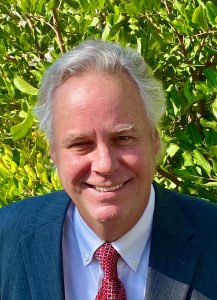
Flanigan’s Eco-Logic: Restoration Ranch
Chris Avery, my stepbrother, was killed by a bank robber. Literally. A little over a year ago, and just before Christmas, he drove to a supermarket to get citrons for the fruit cakes he and his wife were baking, their holiday tradition. As he turned into the market, a getaway car blasted into him and killed him on the spot.

Two days ago, I was in the outskirts of Denver, Colorado. First up was the dedication ceremony for Restoration Ranch. Held in the Lakewood City Council chambers, the seats were largely full, full of blue uniforms, police and fire, as well as sheriffs in green and khaki. They were all present to support one woman’s vision, Kathryn’s vision.
Kathryn Avery, Chris’s wife, made a pact with herself not to let Chris’s untimely death ruin her life. She was determined to turn tragedy into something positive. After Chris’s death, and as justice was served for each of the three in the getaway car, she bonded with the first responders. They’d gone out of their way after the accident to support her, to welcome her at the police department. They came by her home to admire her Christmas lights. She baked for them. Kathryn was struck by how giving these men and women are, even in the face of terrible tragedies. They do their jobs with valor; working from tragedy to tragedy with no closure.
She had an idea: She decided to create a place where first responders can go for restoration. Group therapy, hiking, counseling… support for those that are supporting us every day. They can’t take grief home to their families; they often just continue their work. Many burn out and retire early. Kathryn’s ranch honors these and offers lodging and meals free of charge to first responders. At Restoration Ranch they’ll relax, reflect, recreate, and focus on wellness.

Restoration Ranch is about to open its doors. It will be welcoming Jefferson County first responders, dispatchers, emergency room personnel, judicial staff members, and their families to gather to process. The location of the ranch is not made public in the interest of the guests’ safety. Kathryn is moving to the ranch, to live there and help oversee and administer its early years of operations.

That afternoon, family and friends gathered at a church near the buffalos off Interstate 70 in Golden. Behind the altar, a majestic view of the snow-laden Colorado Rockies. A large photo of Chris, two wooden urns of different sizes because the first one wasn’t quite big enough. A eulogy by Chris’s college roommate highlighted his passions from Porsches to skiing and fine single malts. My brother “gave voice” to Chris’s beloved Martin guitar and sang two beautiful songs. The service was capped off by a deep and powerful eulogy by Kathryn of Chris, her true love and light. She poured her heart into his tribute. Chris did not die in vain, Kathryn attested. She’s clearly made something truly great of Chris’s passing.
A quiet time driving back to Snowmass. So much to process, the marvel I’d just witnessed. A very powerful day marked by both loss and birth. I pass two groups of mountain goats along the interstate in Georgetown. Through the Eisenhower Tunnel, and then just outside I pass a large pick-up with a large trailer, both completely engulfed in flames.
Cresting the Vail Pass, I breathe in the stunning view of some of Colorado’s great fourteeners. There’s a heavy blanket of snow in the mountains; the ski areas just closed. I pass Vail and Beaver Creek. The road pushes into the Glenwood Canyon with its steep walls. I’m always impressed by how the Colorado River, Interstate 70, and the railroad wind through the canyon.
Ah, at last the Conoco at Snowmass where I turn into the darkness of our own canyon. What a day. My mind is full, full of awe and gratitude.
Quote of the Week
“Climate and sustainability is going to be the new computer science. This is what young people want to work on for their lives, for all the right reasons.”
Class 8 Trucks Now Electric
Two hundred miles of range! Imagine, a full-size semi, 18-wheeler, five axles, a 53-foot long trailer… and all-electric! These are Class 8 trucks, heavy trucks, and they are going electric fast. The infamous Mack garbage trucks now come in electric models!
Some call it “the Tesla Effect.” In addition to electric passenger vehicles (EVs), all kinds of vehicles are now going electric, from snowmobiles to lawn care equipment, boats and planes. Now race cars and Corvettes! Even the biggest trucks, the Class 8 warriors, are rolling out electric models.
A quick primer on the classes of trucks: There are eight classes for trucks based on the maximum loaded weight of the truck, the Gross Vehicle Weight Rating (GVWR). Small pickups, like my Tacoma, are Class 1 and when fully loaded can weigh no more than 6,000 pounds. Classes 2, 3, and 4 are larger pickups. Classes 5,6 and 7 are commercial trucks of varying functions. Class 7 are heavy-duty trucks with a GVWR of 26,000 – 33,000 pounds. Anything above that – such as semis, dump and garbage trucks – that weigh more than 33,000 pounds are considered Class 8.
There are a pack of truck manufacturers that are scrambling to bring e-trucks to market: Daimler Truck, Volvo, Navistar, Hyundai, Hino, Peterbilt, Kenworth, International, Mack, and BYD. Then there are the e-truck start-ups including Proterra, Lion, Nikola, Hyzon, and Xos. Most of these trucks are configured with batteries. Some employ hydrogen fuel cells.
Dozens of electric semis and heavy-duty truck models were on display at the Advanced Clean Transportation Expo at the Long Beach Convention Center this past week. The hydrogen fuel cell semi Nikola Tre was there. Freightliner’s electric semi gets 230 miles of range on a single charge. Many of these will be deployed at Southern California ports to combat air quality issues. Surging oil prices are making these new market entrants all the more popular.
Noticeably absent was Tesla despite its 2017 announcement that it would make a semi that gets 500 miles per charge. That hasn’t happened yet. But the CEO of Navistar claims that the cost parity of electric trucks is coming much sooner than anyone thinks. Sure, they cost more to buy… but much less to operate. In California, there are rebates for up to $120,000 per e-truck.
Navistar’s eMV truck gets 134 miles of range. The company has its sites on 500 miles of range, e-trucks powered by a megawatt-hour of stored energy on board. Navistar expects those trucks to reach the market by 2025. Navistar is an affiliate of the Volkswagen Group: 50% of its sales will be electric by 2030, and 100% by 2040.
Volvo is offering the widest range of heavy-duty electric vehicles in Europe, some configured as garbage trucks. With 100 – 300 kWh battery packs, these trucks can operate for 124 – 188 miles per charge. Volvo’s tractor-trailers have 375 and 565 kWh battery packs, the larger providing up to 230 miles of range. Fifty of these were recently purchased and will be in operation at the Port of Long Beach, one of the country’s busiest freight hubs. The Port is investing in a “charging plaza” for trucks that will feature 26, 360-kilowatt charging bays.
Mack trucks offer the LR Electric with 376 kWh on board. These electric trucks – primarily garbage trucks – have 530 HP of peak capacity, the combined effect of 2 AC motors. Three-mode regenerative braking recaptures some energy as these trucks stop hundreds of times a day. They cost ~$550,000, nearly double that of their diesel-powered sisters which cost ~$340,000.
Texas Homebuilder Plans 200,000 Microgrids
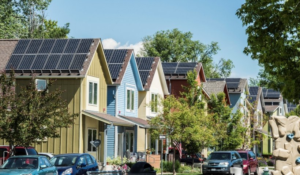
Horton World Solutions (HWS), a Texas-based builder that focuses on sustainability, is now planning to build 200,000 homes that are each an energy-resilient microgrid. Given increased climate consequences, resilience is desirable and marketable. Most of the HWS homes will be built in the Dallas – Fort Worth area. They will achieve resilience by incorporating batteries.
Terry Horton is the CEO of Horton World Solutions. He and his brother also own DR Horton, the largest home builder in the country. The HWS home microgrids will add $20,000 to the cost of each home. Where applicable, the homeowners will use their batteries to participate in energy markets, sharing revenues with the developer.
The homes will employ a zinc-ion battery design developed by Salient Energy. These are thought to be safer than “traditional” lithium-ion batteries with the same power, performance, and size. The zinc-ion battery chemistry was developed at the University of Waterloo in Ontario. According to Ryan Brown, cofounder of Salient, zinc-ion is readily available and does not have the thermal runaway safety issue that plagues lithium-ion.
In 2021, Salient got a $1.6 million grant from the California Energy Commission to investigate zinc-ion batteries as alternatives to lithium-ion. By 2025, Salient expects to produce batteries at half the cost of lithium-ion. Salient’s four-hour batteries can also be ganged together for a longer duration.
In related news, 600 homes in the Silvies Valley Ranch, near Burns, Oregon, are now powered by solar and storage microgrids. Going off-grid was less expensive than paying the local utility $7 million to run lines to the development. Meanwhile, in California, wildfires and Public Safety Power Shut-off events (PSPS) are driving consumers to microgrids. Luxury homebuyers reportedly are not solely interested in their returns…. they want resilience.
China’s Boasts World’s Biggest Clean Energy Corridor

The Three Gorges Corporation reports that its six dams along the Yangtze River have a combined 62 GW capacity and have generated over 3 trillion kWh of electricity since 1981 when the first dam was built. The clean energy corridor, made up of the Baihetan, Wedongde, Xiluodu, Xiangjiaba, Gezhouba, and Three Three Gorges Dams has avoided the combustion of 910 million tonnes of coal, stemming the tide of 240 million metric tonnes of emissions. The combined 101 generating units there form the largest clean energy corridor in the world. That compares with the Columbia River Basin watershed… made up of 274 dams including 16 in British Columbia. The Columbia River watershed has a combined capacity of 36 GW.
The Vegas Turf-Ban Bill
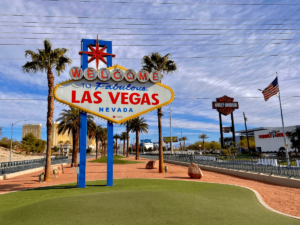
The Colorado River watershed is in trouble as a result of a 20-year mega-drought. Lake Mead’s water level is lower than at any point since the dam was built in the 1930s. The level has been declining since 2000, so much so that the pipes that draw water from the lake are now too high. A new pumping station was required to deliver water despite these record low levels.
The Las Vegas region gets 90% of its water supply from the Colorado River. Now, Southern Nevada, including the City of Las Vegas, has banned lawns. Nevada’s AB 356 is a mandate. Turf removal is now required in Southern Nevada… a service area providing water to 2 million people. The Southern Nevada Water Authority claims that indoor water use is carefully controlled, and all wastewater is recycled. But outdoor water use is responsible for 60% of consumption, and all of it ends up lost to evaporation.
As I write this piece, sod cutters are slicing away turf from the soil in Vegas. Later these areas will be refashioned with gravel marked by plants such as Desert Spoon and Red Yucca. The law is the first of its kind in the nation: “Non-functional areas” such as roadway medians that serve only aesthetic purposes but that must be irrigated, must now be replanted with desert-friendly landscaping. There are useless pieces of grass everywhere… in medians, roundabouts, and commercial office parks.
“Functional turf” includes athletic fields, cemeteries, and in some cases, lawns in housing developments. There are provisions for “pet relief turf.” The law passed with bipartisan support and established an advisory committee to rule on functional versus non-functional turf.
The turf-ban bill follows lots of programs to reap voluntary water conservation efforts. Southern Nevada Water Authority’s Cash-for-Grass program began in 1999. There have been watering limits and wastewater patrols and investigators. Building codes have successfully limited the amount of turf in new developments.
These efforts have cut water use. Even as the region’s population has increased by 20%, absolute water use has remained flat. But more, a lot more, needs to be done. The turf-ban bill is tough but may well be effective. Switching from lawn to drip-irrigated, drought-tolerant plants can reduce water use by 70%, and even more if the turf is replaced with artificial turf.
AB 356 is anticipated to remove 3,900 acres of grass, potentially saving 9.5 billion gallons of water – equivalent to 11 gallons per person per day – and equivalent to 10% of the region’s Colorado River allocation. Property owners can get a rebate of $3 a square foot from the SNWA to help with removal costs.
Stanford’s New School of Climate
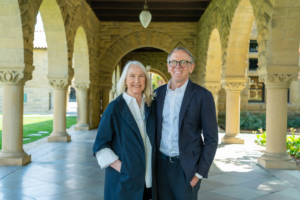
Image courtesy of Edward Caldwell
It will be the first new school at Stanford University in 70 years. It is funded by billionaire John Doerr, a venture capitalist and principal at Kleiner Perkins. He made his fortune funding companies including Slack, Google, and Amazon.
Doerr and his wife Ann are now responsible for the second-largest gift to an academic institution, and the largest ever to establish a new school within a university. The Doerrs are giving $1.1 billion to Stanford for a new climate school. The largest gift? Michael Bloomberg gave $1.8 billion to Johns Hopkins University in 2018.
The New York Times called Doerr one of the “ultra-wealthy” that are stepping up and donating huge sums to fight climate change. He joins the likes of Bezos, Gates, and Bloomberg. According to its new dean, the school will not take policy positions but will work with oil companies on solutions. The school will place Stanford at the center of public and private efforts to wean the world of fossil fuels. It will be made up of a complement of traditional courses, such as Earth Sciences, as well as interdisciplinary studies.
Columbia and other universities are also developing interdisciplinary schools for sustainability, but the Stanford Doerr School of Sustainability will be the best-funded. It will begin with 90 faculty with a plan to add 60 more faculty in ten years. Stanford has raised an additional $590 million for the school. Two new buildings will be built on campus.
Green Roofs in France

The French Parliament has passed a new law requiring that all new commercial buildings have either solar panels or green roofs. Early advocates were pushing for the entire rooftops of new buildings to be green. Given the cost of doing so, the government lessened the requirement. Now only partially covered is the requirement. A positive step. The goal is to reduce rooftop temperatures, and reduce the urban heat island effect. According to the U.S. EPA, green roofs’ temperatures can be 30 – 40 degrees lower – cutting cooling costs in some cases – and ambient air temperatures can be tempered by 5 degrees.
Clean Heat Standard
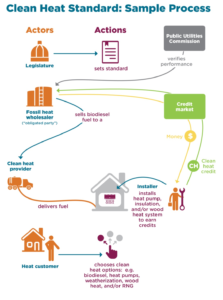
Graphic Courtesy of Energy Action Network
What’s a clean heat standard? It’s a regulatory mechanism aimed at driving down emissions from heating fuels. It’s a part of the young and important movement to decarbonize buildings. Yes, renewable portfolio standards have greened the power grid and continue to do so. EVs of all kinds are greening and decarbonizing mobility. In California, EV adoption is being supported with Low Carbon Fuel Standard credits.
Now progressive states are focusing on decarbonizing buildings and their heating systems. They are at the cutting edge of the Clean Heat Standard. In Colorado, where 70% of homes use natural gas heating, Governor Jared Polis signed the Clean Heat Standard into law last year. Natural gas providers there must reduce their emissions by 4% by 2025, and by 22% by 2030 from 2015 levels. One compliance strategy is to mix hydrogen into the natural gas supply.
In Vermont, heating is responsible for 35% of the State’s emissions. Promoted by Vermont’s Energy Action Network, the Clean Heat Standard passed both the House and Senate in early 2022, It would have required fossil fuel corporations and utilities that sell heating fuels to reduce “climate pollution” over time and in line with Vermont’s Global Warming Solutions Act passed in 2020 (Act 153). The law would require heating fuel providers to either provide cleaner fuels, or to pay for weatherization, heat pumps, and advanced wood heating systems… just as electric utilities have been required to reduce their customers’ power consumption for years. On May 6, 2022, however, the bill H.715 was vetoed by Governor Phil Scott. While concerned about climate change, he claimed that the authors of the sweeping regulation did not fully present its costs and impacts. An override failed in the House by a single vote.
Instituting a clean heat standard is one of several tools to cut natural gas use, and to limit methane leakage and GHG impact. Many California cities have banned the use of natural gas in new construction. New York City has banned new gas hookups, weathering a storm of criticism and battle over regulating how customers cook and stay warm. These laws are requiring electric stoves and furnaces in new buildings.
One of the drivers of the Clean Heat Standard is the realization that natural gas – more specifically the leakage of methane – is bad news. Methane’s potency was underscored by a United Nations report last year that warned of methane’s “supercharged GHG impact.” It called for an urgent crackdown on the use of methane. The report’s authors concluded that new natural gas hookups are not compatible with international climate targets, “without relying on future massive-scale deployment of unproven carbon-removal technologies.”
The NetPositive Podcast Updates

Recently Released:
- The NetPositive Podcast: A Conversation with Laurel Rothschild, Vice President, The Energy Coalition
Check out and subscribe to The NetPositive with Ted Flanigan on Spotify, Apple, and Google. Episodes include Convos, Crash Courses, and EcoNet News.
